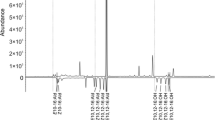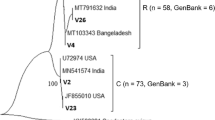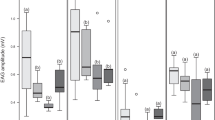Abstract
The fall armyworm, Spodoptera frugiperda (Lepidoptera: Noctuidae), is one of the most important pests of corn in Latin America. This insect presents two strains with behavioural and genetic differences. In Mexico, both strains are present, and at least two different FAW populations have been reported within the corn-strain. The objective of this study was to gather evidence of whether pheromonal communication varies among different S. frugiperda populations infesting corn in Mexico. First, we investigated any qualitative or quantitative difference in the composition of sex pheromones among populations; second, we studied whether male antennal responses to pheromone components vary among populations; and, finally, we investigated whether males from a region can discriminate between a synthetic pheromone blend characteristic of their region and blends formulated with the ratio of pheromone compounds emitted by females from other populations. Sex pheromone components were sampled by solid-phase microextraction and identified by gas chromatography coupled to mass spectrometry. Females from all populations consistently released three compounds: (Z)-9-tetradecenyl acetate (Z9-14:OAc), (Z)-11-hexadecenyl acetate (Z11-16:OAc) and (Z)-7-dodecenyl acetate (Z7-12:OAc). Our results showed that Z9-14:OAc and Z7-12:OAc evoked the highest and most variable antennal responses among the populations studied compared to Z11-16:OAc. However, males did not discriminate between local pheromone blends and those formulated from other populations in a field test. These results show that although there is geographic variation in the ratio of pheromone components and in the peripheral reception of them, males were not differentially attracted to different pheromone blends in the field.


Similar content being viewed by others
References
Andrade R, Rodriguez C, Oechlschlager AC (2000) Optimization of a pheromone lure for Spodoptera frugiperda (Smith) in Central America. J Braz Chem Soc 11:609–613
Andrews KL (1980) The whorlworm, Spodoptera frugiperda, in Central America and Neighboring areas. Fla Entomol 63:456–467
Batista-Pereira LG, Stein K, de Paula AF, Moreira JA, Cruz I, Figueiredo Mde L, Perri J Jr, Corrêa AG (2006) Isolation, identification, synthesis, and field evaluation of the sex pheromone of the Brazilian population of Spodoptera frugiperda. J Chem Ecol 32:1085–1099
Blanco CA, Pellegaud JG, Nava- Camberos U, Lugo-Barrera D, Vega-Aquino P, Coello J, Terán-Vargas AP, Vargas-Camplis J (2014) Maize pests in Mexico and challenges for the adoption of integrated pest management programs. J Integr Pest Manag 5:1–9
Clark PL, Molina-Ochoa J, Martinelli S, Skoda SR, Isenhour DJ, Lee DJ, Krumm JT, Foster JE (2007) Population variation of the fall armyworm, Spodoptera frugiperda, in the Western Hemisphere. J Insect Sci 7:1–10
Descoins C, Silvain JF, Lalannecassaou B, Cheron H (1988) Monitoring of group pests by sexual trapping of males in the French West Indies and Guyana. Agric Ecosyst Environ 21:53–65
Farias PRS, Barbosa JC, Busoli AC, Overal WL, Miranda VS, Ribeiro S (2008) Spatial analysis of the distribution of Spodoptera frugiperda (J. E. Smith) (Lepidoptera: Noctuidae) and losses in maize crop productivity using geostatistics. Neotrop Entomol 37:321–327
Fleischer SJ, Harding CL, Blom PE, White J, Grehan J (2005) Spodoptera frugiperda pheromone lures to aviod nontarget captures of Leucania phragmatidicola. J Econ Entomol 98:66–71
Gemeno C, Haynes KF (2001) Impact of Photoperiod on the Sexual Behavior of the Black Cutworm Moth (Lepidoptera: Noctuidae). Environ Entomol 30:189–195
Georgen G, Kumar PL, Sankung SB, Togola A, Tamò M (2016) First report of outbreaks of the fall armyworm Spodoptera frugiperda (J E Smith) (Lepidoptera, Noctuidae), a new alien invasive pest in West and Central Africa. PLoS One 11(10):e0165632. https://doi.org/10.1371/journal.pone.0165632
Groot AT, Marr M, Schöfl G, Lorenz S, Svatos A, Heckel DG (2008) Host strain specific sex pheromone variation in Spodoptera frugiperda. Front Zool. https://doi.org/10.1186/1742-9994-5-20
Groot AT, Classen A, Staudacher H, Schal C, Heckel DG (2010a) Phenotypic plasticity in sexual communication signal of a noctuid moth. J Evol Biol 23:2731–2738
Groot AT, Marr M, Heckel DG, Schöfl G (2010b) The roles and interactions of reproductive isolation mechanisms in fall armyworm (Lepidoptera: Noctuidae) host strains. Ecol Entomol 35:105–118
Hardke JT, Leonard BR, Huang F, Jackson RE (2011) Damage and survivorship of fall armyworm (Lepidoptera: Noctuidae) on transgenic field corn expressing Bacillus thuringiensis Cry proteins. Crop Prot 30:168–172
Juárez ML, Murúa MG, García MG, Ontivero M, Vera MT, Vilardi JC, Groot AT, Castagnaro AP, Gastaminza G, Willink E (2012) Host association of Spodoptera frugiperda (Lepidoptera: Noctuidae) corn and rice strains in Argentina, Brazil, and Paraguay. J Econ Entomol 105:573–582
Jurenka RA (2004) Insect pheromone biosynthesis. Top in Curr Chem. 239:97–132
Lassance JM (2010) Journey in the Ostrinia world: from pest to model in chemical ecology. J Chem Ecol 36:1155–1169
Lewter JA, Szalanski AL, Nagoshi RN, Meagher RL, Owens CB et al (2006) Genetic variation within and between strains of the fall armyworm, Spodoptera frugiperda (Lepidoptera: Noctuidae). Fla Entomol 89:63–68
Lima ER, McNeil JN (2009) Female sex pheromones in the host races and hybrids of the fall armyworm, Spodoptera frugiperda (Lepidoptera: Noctuidae). Chemoecology 19:29–36
López-Edwards M, Hernández-Mendoza JL, Pescador-Rubio A, Molina-Ochoa J, Lezama-Gutiérrez R, Hamm JJ, Wiseman BR (1999) Biological differences between five populations of fall armyworm (Lepidoptera: Noctuidae) collected from corn in Mexico. Fla Entomol 82:254–262
Lu YJ, Adang MJ (1996) Distinguishing fall armyworm (Lepidoptera: Noctuidae) strains using a diagnostic mitochondrial DNA marker. Fla Entomol 79:48–55
Machado CA, Wunder M, Baldissera VD, Oliveira JV, Fiúza LM, Nagoshi RN (2008) Molecular characterization of host strains of Spodoptera frugiperda (Lepidoptera: Noctuidae) in Southern Brazil. Ann Entomol Soc Am 101:616–619
Malo EA, Castrejón-Gómez VR, Cruz-López L, Rojas JC (2004) Antennal sensilla and electrophysiological response of male and female Spodoptera frugiperda (Lepidoptera: Noctuidae) to conspecific sex pheromone and plant odors. Ann Entomol Soc Am 97:1273–1284
Mitchell ER, Tumlinson JH, McNeil JN (1985) Field evaluation of commercial pheromone formulations and traps using a more effective sex pheromone blend for the fall armyworm (Lepidoptera: Noctuidae). J Econ Entomol 78:1364–1369
Nagoshi RN, Meagher RL, Adamczyk JJ, Braman SK, Brandenburg RL, Nuessly G (2006) New restriction fragment length polymorphisms in the cytochrome oxidase I gene facilitate host strain identification of fall armyworm (Lepidoptera: Noctuidae) populations in the southeastern United States. J Econ Entomol 99:671–677
Nagoshi RN, Robert LM, Mirian HR (2014) Assessing the resolution of haplotype distributions to delineate fall armyworm (Lepidoptera: Noctuidae) migratory behaviors. J Econ Entomol 107:1462–1470
Pashley DP (1986) Host-associated genetic differentiation in fall armyworm (Lepidoptera, Noctuidae): a sibling species complex. Ann Entomol Soc Am 79:898–904
Pashley DP (1988) Current status of fall armyworm host strains. Fla Entomol 71:227–234
Pashley DP (1989) Host-associated differentiation in armyworms (Lepidoptera: Noctuidae): an allozymic and mitochondrial DNA perspective. Systematics Association Special Volume Series: 103–114
Pashley DP, Hammond AM, Hardy TN (1992) Reproductive isolating mechanisms in fall armyworm host strains (Lepidoptera, Noctuidae). Ann Entomol Soc Am 85:400–405
Pecina-Quintero V, Anaya-López JL, Cortez-Mondaca E, Nuñez-Colín CA, Herrera-Corredor C, Montes-García N, Jimenez-Becerril MF, Gámez-Vazquez AJ (2015) Genetic characterization of Spodoptera frugiperda (Lepidoptera: Noctuidae) in Mexico using AFLP markers. Southwest Entomol 40:545–553
Perez-Zubiri JR, Cerna-Chavez E, Aguirre-Uribe LA, Landeros-Flores J, Harris MK, Rodriguez-Herrera R (2016) Population variability of Spodoptera frugiperda (Lepidoptera: Noctuidae) in maize (Poales: Poaceae) associated with the use of chemical insecticides. Fla Entomol 99:329–331
Prowell DP, McMichael M, Silvain JF (2004) Multilocus genetic analysis of host use, introgression, and speciation in host strains of fall armyworm (Lepidoptera: Noctuidae). Ann Entomol Soc Am 97:1034–1044
R Core Team (2016) R: A language and environment for statistical computing. R Foundation for Statistical Computing, Vienna, Austria. URL http://www.R-project.org/
Raina AK (2003) Pheromone production in corn earworm: effect of temperature and humidity. Southwest Entomol 28:115–120
Reddy GVP, Guerrero A (2004) Interactions of insect pheromones and plant semiochemicals. Trends Plant Sci 9:253–261
Rojas JC, Virgen A, Cruz-López L (2003) Chemical and tactile cues influencing oviposition of a generalist moth, Spodoptera frugiperda (Lepidoptera: Noctuidae). Environ Entomol 32:1386–1392
Rosas-García NM, Herrera-Mayorga V, Rivera G, Mireles-Martínez M, Paredes Sánchez FA, Villegas-Mendoza JM (2016) Identificación de Biotipos de Spodoptera frugiperda Provenientes de Plantas Hospederas de Maíz en Diferentes Regiones de México. Southwest Entomol 41:761–770
Schöfl G, Heckel DG, Groot AT (2009) Time-shifted reproductive behaviours among fall armyworm (Noctuidae: Spodoptera frugiperda) host strains: evidence for differing modes of inheritance. J Evol Biol 22:1447–1459
Schöfl G, Dill A, Heckel DG, Groot AT (2011) Allochronic separation versus mate choice: nonrandom patterns of mating between fall armyworm host strains. Am Nat 177:470–485
Sekul AA, Sparks AN (1967) Sex pheromone of the fall armyworm moth: Isolation, identification and synthesis. J Econ Entomol 60:1270–1272
Sparks AN (1979) A review of the biology of the fall armyworm. Fla Entomol 62:82–87
Stokstad E (2017) New crop pest takes Africa at lightning speed. Science. https://doi.org/10.1126/science.356.6337.473
Tumlinson JH, Mitchell ER, Teal PEA, Heath RR, Mengelkoch LJ (1986) Sex pheromone of fall armyworm, Spodoptera frugiperda (J.E. Smith). Identification of components critical to attraction in the field. J Chem Ecol 12:1909–1926
Unbehend M, Haenniger S, Meagher RL, Heckel DG, Groot AT (2013) Pheromonal divergence between two strains of Spodoptera frugiperda. J Chem Ecol 39:364–376
Unbehend M, Hänniger S, Vásquez GM, Juárez ML, Reisig D, McNeil JN, Meagher RL, Jenkins DA, Heckel DG, Groot AT (2014) Geographic variation in sexual attraction of Spodoptera frugiperda corn- and rice-strain males to pheromone lures. PLoS One 9:1–11
Whitford F, Quisenberry SS, Riley TJ, Lee JW (1988) Oviposition preference, mating compatibility and development of two fall armyworm strains. Fla Entomol 71:234–243
Wicker-Thomas C (2011) Evolution of insect pheromones and their role in reproductive isolation and speciation. Ann Soc Entomol Fr 47:55–62
Acknowledgements
We thank Javier Valle Mora for his advice in the statistical analysis, José Higinio López Urbina for the preparation map of the study area, Armando Virgen Sanchez for his support during the travel to collect the biological material, and Antonio Santiesteban Hernández for his technical support in the chemical identification. We are grateful to Astrid Groot for her constructive comments on an earlier version of the manuscript. SCE (378068) acknowledges to Consejo Nacional de Ciencia y Tecnología (Mexico) for a scholarship.
Author information
Authors and Affiliations
Corresponding author
Ethics declarations
Conflict of interest
The authors declare that there is no conflict of interest.
Ethical approval
The article does not contain any studies with human participants only with insects. All applicable international, national and institutional guidelines for the care and use of insects were followed.
Additional information
Communicated by P.G. Becher.
Rights and permissions
About this article
Cite this article
Cruz-Esteban, S., Rojas, J.C., Sánchez-Guillén, D. et al. Geographic variation in pheromone component ratio and antennal responses, but not in attraction, to sex pheromones among fall armyworm populations infesting corn in Mexico. J Pest Sci 91, 973–983 (2018). https://doi.org/10.1007/s10340-018-0967-z
Received:
Revised:
Accepted:
Published:
Issue Date:
DOI: https://doi.org/10.1007/s10340-018-0967-z




